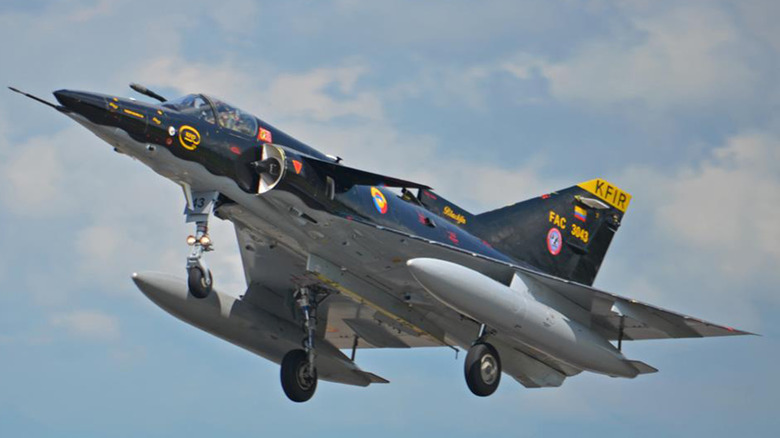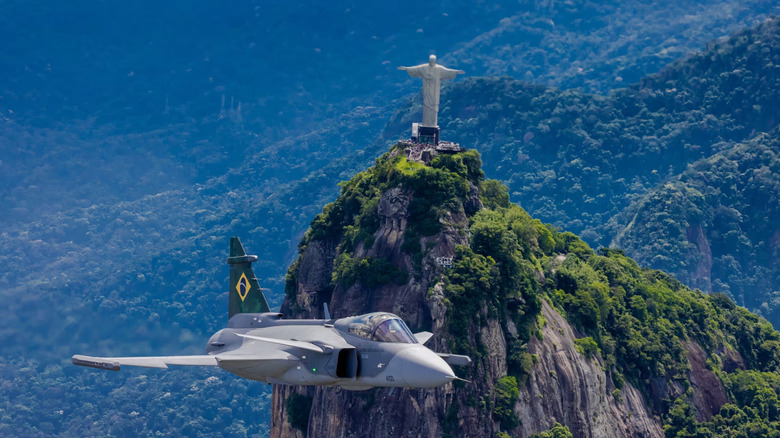Colombia Is Seeking To Modernize Its Air Force With These Jets And Weapons
The Fuerza Aeroespacial Colombiana (Colombian Aerospace Force) has relied on the Israeli-built Kfir fighter since its northern neighbor Panama was ruled by Manuel Noriega. This jet first entered service with its home country's Air Force in the 1970s and it's fair to say that it is no longer a pilots' favorite. The half-century old technology is also becoming an issue for technicians as keeping these planes in the air safely gets more challenging with time.
Colombia's government shopped around with aerospace companies around the world to choose its next primary fighter jet. Among the considerations were America's F-16, France's Dassault Rafale, and the Chinese J-10CE. After lots of deliberation, Bogota struck a $1.9 billion deal with Saab to buy 18 Gripen E jets from the Swedish company. The deal also included renewable energy and infrastructure improvements and a line of credit from the Swedish government, and Colombia showed off its new planes at the nation's International Aeronautics and Space Fair (F-AIR 2025) in July.
For the nation of more than 50 million people that shares a border with five other countries the Gripen is a huge climb in terms of fighter technology. The Kfir debuted in 1975, but its design roots go back even further. The plane is actually a reverse-engineered copy of France's Mirage 5, a jet that first flew in 1967. Although the Kfir's replacement can't be considered a fifth-generation fighter like the F-35 Lightning II, it still goes a long way in bringing Colombia's air defenses up to date. Let's take a closer look at the jet the country will use to close that generational gap.
about the Gripen E-series fighter
The Gripen E Multirole fighter is the latest generation of the venerable machine and is powered by a GE F414G turbofan engine that can take it as fast as Mach 2 (over 1,500 mph) at altitude. The Gripen E has a maximum take-off weight of 16,500 kilograms (just over 18 US tons) and a design lineage that goes back to the 1980s. The E-Series is the latest member of the Gripen family and was introduced in 2014 as an upgrade over the previous C/D generation. Improvements included new avionics, greater range, and increased payload options. The Gripen-E is designed to operate in harsh Scandinavian conditions and can be scrambled from unimproved runways or roads. This operational ability made it an enticing buy for Brazil's Força Aérea Brasileira and should be of help in the mountains and rainforests of Colombia.
It's also worth noting that although the original Gripen design is some decades old, the electronics and avionics are fully state of the art. Pilots have access to a digital cockpit including helmet-mounted and heads-up displays. The electronics suite also includes an advanced electronic weapons management and intelligence gathering system, and these and other features combine to make up Saab's AI-powered Human-Machine Collaboration system. For battle the Gripen-E has ten pylons that can carry an array of pods and weapons like the long-lived Sidewinder, IRIS-T, R-Darter, A-Darter, and Derby missiles. It can be outfitted for a wide range of combat missions, and ground crews can turn one around for another sortie in as little as 10 minutes. With all these advantages, Colombia's military leaders hope the Gripen E will keep the FAC flying for the next 50 years.

